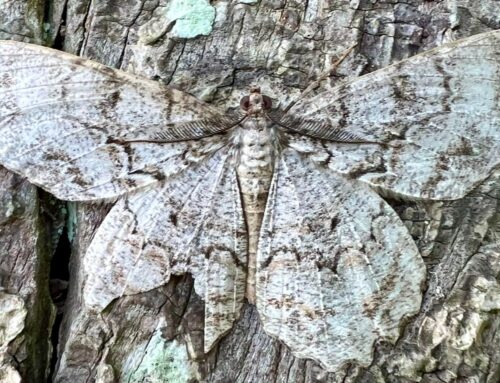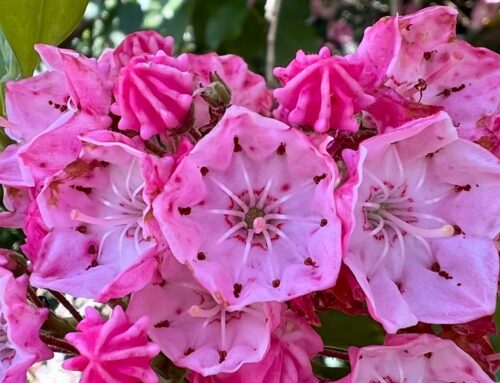Let’s look at leaves! Now that the leaves are back on all of our trees, it’s kind of hard not to look at them – they are so fresh and green, just begging for a closer look. Leaves come in all different shapes and sizes so let’s narrow it down and focus on a few trees with palmate leaves. This handful of hand-shaped leaved trees look a lot alike so I’ll give you some tips on how to tell them apart.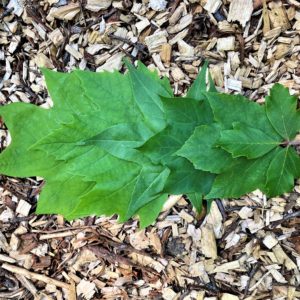
Before we jump into the trees themselves, I’m going to introduce some terms that will help you understand their leaves a bit better. Let’s start by learning the different parts of a leaf:
At first glance, we have a whole lot of green and a tiny stalk. The stalk is called the petiole which supports the leaf and attaches it to a branch. All of this green leaf surface is called the leaf blade. This is where all of the photosynthesis magic happens, making food for the tree.
Looking closer at the leaf blade, you’ll notice some lines. These lines are called veins which are thin vessels that hold some of the tree’s plumbing inside. Remember the words xylem and phloem? Xylem moves water and phloem moves the food made during photosynthesis. The vein in the center of the leaf that kind of cuts the leaf in half is the midrib.
These terms are important to know and recognize as we’re thinking about palmate leaves – the major veins are spreading out to the lobes of the leaf from a single point at the base of the leaf. Kind of like how fingers spread out from your hand. Each of your fingers would then be the lobes on the leaf. Lobes are how the leaf edge is divided up in some leaves.
Now let’s think about the edge of the leaf. What you want to focus on is texture – is it a smooth edge or does it look like someone cut it with pinking shears? If it looks like it has a zig-zag pattern, we would say that the leaf edge is toothed. An individual tooth on a leaf is a small, notched projection that comes in all different sizes and patterns, depending on the tree.
Here is a quick guide to identifying some common trees with palmate leaves:
Maple (Acer sp.)
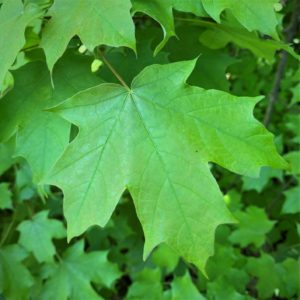
Leaf arrangement: opposite
Leaf division: 3, 5 or 7 lobes (each lobe is less than 4 inches in size)
Leaf edge: various; smooth and toothed
Hints: look for the winged seeds called samaras
Notes: Acer is a genus with over 100 different species of maples so there will be many different variations. There are also exceptions to the rules above. Paperbark maple (Acer griseum) and box elder (Acer negundo) are two examples of maples with trifoliate compound leaves which means that their leaf blade is divided into three smaller leaflets.
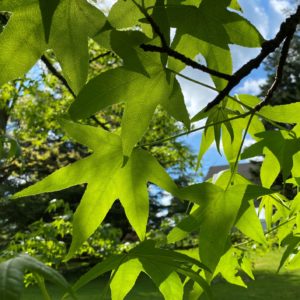
Sweetgum (Liquidambar styraciflua)
Leaf arrangement: alternate
Leaf division: 5 lobes, sometimes 7
Leaf edge: very fine toothing
Hints: branches can have corky ridges. Look for the spiky fruits that hang from the tree or can be found on the ground beneath.
Notes: star-shaped leaves with pointed lobes but don’t get it confused with Shantung maple (Acer truncatum) or Japanese maple (Acer palmatum).
Sycamore (Platanus occidentalis)
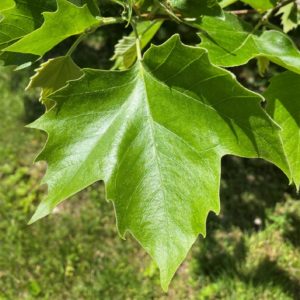
Leaf arrangement: alternate
Leaf division: 3-5 shallow lobes (lobes can extend beyond 4 inches wide when mature)
Leaf edge: toothed
Hints: bark has a “camo” appearance and can be smooth, as well as flaky. You might notice seed balls hanging from branches or on the ground beneath.
Notes: sycamores like to grow in wet areas; knowing where a tree is growing may help you identify it. Also, don’t be fooled by sycamore maple (Acer pseudoplatanus) – look at the leaf arrangement to verify alternate or opposite leaves.
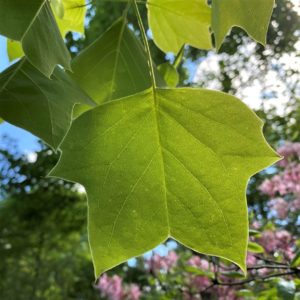
Tulip tree (Liriodendron tulipifera)
Leaf arrangement: alternate
Leaf division: 4 lobes, sometimes 6
Leaf edge: smooth
Hints: the top of the leaf can appear trimmed or flat and the leaf shape looks like a tulip flower or cat’s face. In May-June, you can look for flowers high up in the trees – yellow/green with an orange band at the base of the petals. In the fall, you can look for seeds – winged seeds clustered in a cone.
Notes: Tulip trees are usually very tall and very straight, like telephone poles in the woods!
Now that you’ve explored trees with palmate leaves, test your new knowledge and name that tree!





